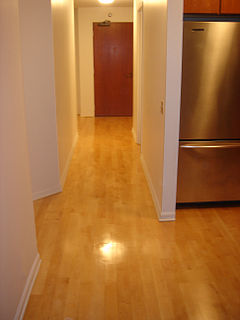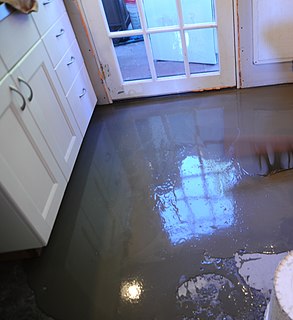Multilaminar wood veneer uses plantation wood to reproduce decorative effects that are typical of quality wood species (often protected and rare). This aids the preservation of biodiversity and complies with the principles of sustainable forest management.

Wood is a porous and fibrous structural tissue found in the stems and roots of trees and other woody plants. It is an organic material, a natural composite of cellulose fibers that are strong in tension and embedded in a matrix of lignin that resists compression. Wood is sometimes defined as only the secondary xylem in the stems of trees, or it is defined more broadly to include the same type of tissue elsewhere such as in the roots of trees or shrubs. In a living tree it performs a support function, enabling woody plants to grow large or to stand up by themselves. It also conveys water and nutrients between the leaves, other growing tissues, and the roots. Wood may also refer to other plant materials with comparable properties, and to material engineered from wood, or wood chips or fiber.
Decoration may refer to:

Biodiversity refers to the variety and variability of life on Earth. Biodiversity is typically a measure of variation at the genetic, species, and ecosystem level. Terrestrial biodiversity is usually greater near the equator, which is the result of the warm climate and high primary productivity. Biodiversity is not distributed evenly on Earth, and is richest in the tropics. These tropical forest ecosystems cover less than 10 percent of earth's surface, and contain about 90 percent of the world's species. Marine biodiversity is usually highest along coasts in the Western Pacific, where sea surface temperature is highest, and in the mid-latitudinal band in all oceans. There are latitudinal gradients in species diversity. Biodiversity generally tends to cluster in hotspots, and has been increasing through time, but will be likely to slow in the future.
In this veneering process, large sheets of veneer are produced on a machine similar to a lathe. These are dyed, spread with suitable adhesives, and then compressed and bonded into thick (typically 70 cm) logs, which are then sliced to create the end product. If the sheets are compressed between platens with an undulating surface, the slice will cross several layers to produce a patterned effect. Many different designs can be obtained by varying the platens, the dyes and the stacking order. [1]

In woodworking, veneer refers to thin slices of wood and sometimes bark, usually thinner than 3 mm, that typically are glued onto core panels to produce flat panels such as doors, tops and panels for cabinets, parquet floors and parts of furniture. They are also used in marquetry. Plywood consists of three or more layers of veneer. Normally, each is glued with its grain at right angles to adjacent layers for strength. Veneer beading is a thin layer of decorative edging placed around objects, such as jewelry boxes. Veneer is also used to replace decorative papers in Wood Veneer HPL. Veneer is also a type of manufactured board.
A lathe is a machine that rotates a workpiece about an axis of rotation to perform various operations such as cutting, sanding, knurling, drilling, deformation, facing, and turning, with tools that are applied to the workpiece to create an object with symmetry about that axis.

A dye is a colored substance that chemically bond to the substrate to which it is being applied, this distinguishes dyes from pigments which do not chemically bind to the material they colour. The dye is generally applied in an aqueous solution, and may require a mordant to improve the fastness of the dye on the fiber.
Although the product may be considered sustainable, multilaminar veneer does have a relatively high carbon footprint due to the numerous dyeing, laminating, pressing, and slicing operations.[ citation needed ]

A carbon footprint is historically defined as the total emissions caused by an individual, event, organization, or product, expressed as carbon dioxide equivalent. Greenhouse gases (GHGs), including carbon dioxide, can be emitted through land clearance and the production and consumption of food, fuels, manufactured goods, materials, wood, roads, buildings, transportation and other services.













